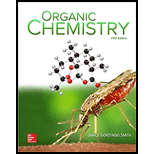
(a)
Interpretation: Enantiomeric excess of the given solution is to be calculated.
Concept introduction: Enantiomeric excess is the excess of major enantiomer over the minor enantiomer. Enantiomeric excess is equivalent to the optical purity. Enantiomeric excess is the fraction of observed rotation of the mixture to specific rotation of the pure enantiomer.
Answer to Problem 5.65P
The enantiomeric excess for the solution with
Explanation of Solution
The specific rotation
The enantiomeric excess is calculated by the formula,
Substitute the values of specific rotation
The enantiomeric excess for the solution is
The enantiomeric excess is calculated by the formula,
Substitute the values of specific rotation
The enantiomeric excess for the solution is
The enantiomeric excess is calculated by the formula,
Substitute the values of specific rotation
The enantiomeric excess for the solution is
The enantiomeric excess for the solution with
(b)
Interpretation: The percent of each enantiomer in the given solution is to be calculated.
Concept introduction: Enantiomeric excess is the excess of major enantiomer over the minor enantiomer. Enantiomeric excess is equivalent to the optical purity. Enantiomeric excess is the fraction of observed rotation of the mixture to specific rotation of the pure enantiomer.
Answer to Problem 5.65P
For the solution with enantiomeric excess
Explanation of Solution
For the solution with enantiomeric excess 30%.
Let A be the major enantiomer and B be the minor enantiomer. The major enantiomer is
Total amount of A is
Hence, the amount of A and B is
For the solution with enantiomeric excess 50%.
Let A be the major enantiomer and B be the minor enantiomer. The major enantiomer is
Total amount of A is
Hence, the amount of A and B is
For the solution with enantiomeric excess 73%.
Let A be the major enantiomer and B be the minor enantiomer. The major enantiomer is
Total amount of A is
Hence, the amount of A and B is
For the solution with enantiomeric excess
(c)
Interpretation: The specific rotation
Concept introduction: Enantiomers are stereoisomers, which are non-superimposable images of each other. They have identical physical and chemical properties in symmetric environment. They rotate the plane-polarized light in equal amounts and in opposite directions.
Answer to Problem 5.65P
The specific rotation
Explanation of Solution
The specific rotation
Enantiomeric excess of the given solution is
(d)
Interpretation: Enantiomeric excess of the given solution is to be calculated.
Concept introduction: Enantiomeric excess is the excess of major enantiomer over the minor enantiomer. Enantiomeric excess is equivalent to the optical purity. Enantiomeric excess is the fraction of observed rotation of the mixture to specific rotation of the pure enantiomer.
Answer to Problem 5.65P
Enantiomeric excess of the given solution is
Explanation of Solution
For the solution containing
The enantiomeric excess of the solution is calculated by the formula,
Substitute the values of percentage of major and minor enantiomers in the above equation.
Hence, the enantiomeric excess of the solution is
Enantiomeric excess of the given solution is
(e)
Interpretation: The
Concept introduction: Enantiomeric excess is the excess of major enantiomer over the minor enantiomer. Enantiomeric excess is equivalent to the optical purity. Enantiomeric excess is the fraction of observed rotation of the mixture to specific rotation of the pure enantiomer.
Answer to Problem 5.65P
The
Explanation of Solution
For the solution containing
The enantiomeric excess of the solution is
The specific rotation
The enantiomeric excess is calculated by the formula,
Substitute the values of specific rotation
Hence, the
The
Want to see more full solutions like this?
Chapter 5 Solutions
PKG ORGANIC CHEMISTRY
- Synthesize 2-Ethyl-3-methyloxirane from dimethyl(propyl)sulfonium iodide using the necessary organic or inorganic reagents. Draw the structures of the compounds.arrow_forwardSynthesize 2-Hydroxy-2-phenylacetonitrile from phenylmethanol using the necessary organic or inorganic reagents. Draw the structures of the compounds.arrow_forwardSynthesize N-Methylcyclohexylamine from cyclohexanol using the necessary organic or inorganic reagents. Draw the structures of the compounds.arrow_forward
- Synthesize N-Methylcyclohexylamine from cyclohexanol using the necessary organic or inorganic reagents. Draw the structures of the compounds.arrow_forwardIf possible, please provide the formula of the compound 3,3-dimethylbut-2-enal.arrow_forwardSynthesize 1,4-dibromobenzene from acetanilide (N-phenylacetamide) using the necessary organic or inorganic reagents. Draw the structures of the compounds.arrow_forward
- Indicate the products obtained by mixing (3-oxo-3-phenylpropyl)triphenylphosphonium bromide with sodium hydride.arrow_forwardWe mix N-ethyl-2-hexanamine with excess methyl iodide and followed by heating with aqueous Ag2O. Indicate the major products obtained.arrow_forwardIndicate the products obtained by mixing acetophenone with iodine and NaOH.arrow_forward
- Indicate the products obtained by mixing 2-Propanone and ethyllithium and performing a subsequent acid hydrolysis.arrow_forwardIndicate the products obtained if (E)-2-butenal and 3-oxo-butanenitrile are mixed with sodium ethoxide in ethanol.arrow_forwardQuestion 3 (4 points), Draw a full arrow-pushing mechanism for the following reaction Please draw all structures clearly. Note that this intramolecular cyclization is analogous to the mechanism for halohydrin formation. COH Br + HBr Brarrow_forward
 ChemistryChemistryISBN:9781305957404Author:Steven S. Zumdahl, Susan A. Zumdahl, Donald J. DeCostePublisher:Cengage Learning
ChemistryChemistryISBN:9781305957404Author:Steven S. Zumdahl, Susan A. Zumdahl, Donald J. DeCostePublisher:Cengage Learning ChemistryChemistryISBN:9781259911156Author:Raymond Chang Dr., Jason Overby ProfessorPublisher:McGraw-Hill Education
ChemistryChemistryISBN:9781259911156Author:Raymond Chang Dr., Jason Overby ProfessorPublisher:McGraw-Hill Education Principles of Instrumental AnalysisChemistryISBN:9781305577213Author:Douglas A. Skoog, F. James Holler, Stanley R. CrouchPublisher:Cengage Learning
Principles of Instrumental AnalysisChemistryISBN:9781305577213Author:Douglas A. Skoog, F. James Holler, Stanley R. CrouchPublisher:Cengage Learning Organic ChemistryChemistryISBN:9780078021558Author:Janice Gorzynski Smith Dr.Publisher:McGraw-Hill Education
Organic ChemistryChemistryISBN:9780078021558Author:Janice Gorzynski Smith Dr.Publisher:McGraw-Hill Education Chemistry: Principles and ReactionsChemistryISBN:9781305079373Author:William L. Masterton, Cecile N. HurleyPublisher:Cengage Learning
Chemistry: Principles and ReactionsChemistryISBN:9781305079373Author:William L. Masterton, Cecile N. HurleyPublisher:Cengage Learning Elementary Principles of Chemical Processes, Bind...ChemistryISBN:9781118431221Author:Richard M. Felder, Ronald W. Rousseau, Lisa G. BullardPublisher:WILEY
Elementary Principles of Chemical Processes, Bind...ChemistryISBN:9781118431221Author:Richard M. Felder, Ronald W. Rousseau, Lisa G. BullardPublisher:WILEY





